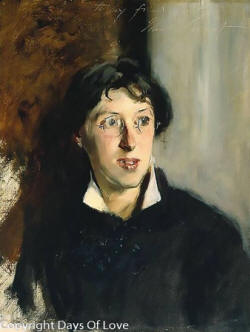
Partner Clementina Anstruther-Thomson
Queer Places:
84 Gower St, Bloomsbury, London WC1E, UK
13 Pembroke Square, Kensington, London W8 6PA, UK
12 Earls Terrace, Kensington, London W8 6LP, UK
Villa Il Palmerino, Via del Palmerino, 10, 50137 Firenze FI, Italia
Cimitero Evangelico agli Allori, Via Senese, 184, 50124 Firenze FI, Italia
 Vernon Lee[1] was the pseudonym of the British writer
Violet Paget (14 October 1856 – 13 February 1935). She is remembered today primarily for her supernatural fiction[2] and her work on aesthetics. Vernon
Lee lived most of the time in Italy, where she was much given to visiting
churches, museums and galleries; doing this in the 1890s with her lover, the
painter Clementina
Anstruther-Thomson, she decided to undertake a study of what happens to
the human body when the mind is occupied with the vista of an aesthetic
object: a building, a decorative jar, a painting. Anstruther-Thomson kept a
diary in which she recorded her reactions, how looking at art made her feel.
She noted her respiration and heart rate, balance, muscular tension, the
manner and speed with which her right and left lungs filled with air. For
example, looking at the Gothic-Renaissance façade of Santa Maria Novella in
Florence one day, she observed that her balance changed and her breathing
deepened. The composer Ethel Smyth,
who had also had a relationship with Lee, made snide comments about what Lee
and Anstruther-Thompson were doing, ‘experimenting’ in art galleries.
Vernon Lee[1] was the pseudonym of the British writer
Violet Paget (14 October 1856 – 13 February 1935). She is remembered today primarily for her supernatural fiction[2] and her work on aesthetics. Vernon
Lee lived most of the time in Italy, where she was much given to visiting
churches, museums and galleries; doing this in the 1890s with her lover, the
painter Clementina
Anstruther-Thomson, she decided to undertake a study of what happens to
the human body when the mind is occupied with the vista of an aesthetic
object: a building, a decorative jar, a painting. Anstruther-Thomson kept a
diary in which she recorded her reactions, how looking at art made her feel.
She noted her respiration and heart rate, balance, muscular tension, the
manner and speed with which her right and left lungs filled with air. For
example, looking at the Gothic-Renaissance façade of Santa Maria Novella in
Florence one day, she observed that her balance changed and her breathing
deepened. The composer Ethel Smyth,
who had also had a relationship with Lee, made snide comments about what Lee
and Anstruther-Thompson were doing, ‘experimenting’ in art galleries.
An early follower of
Walter Pater, she wrote over a dozen volumes of essays on art, music, and travel.
Henry James, who met Lee in
Florence, described her as "exceeding ugly, disputatious, contracdictory and
perverse." She was able to discuss "all things in any language, a superior
talker with a mind." Michael Field, aka
Katharine Harris Bradley and
Edith Emma Cooper, stated that Vernon Lee looked
fifty, but was thirty-nine, and was a Sybil in tailor-made black dress. They
said she was "very ugly, the face long... marked with ruthless features." From
other descriptions, she was strange looking, short sighted, a young woman in
mannish clothes, had short boyish cropped hair, protruding teeth, gleaming
eyes behind thick spectacles, and was a costant talker. "She talked like a
steam enging," Bernard Berenson once noted.

by John Singer Sargent
.JPG)
Villa Il Palmerino
Violet Paget was born in France on 14 October[3] 1856, at Château St Leonard, Boulogne, to British expatriate parents, Henry Ferguson Paget and Matilda Lee-Hamilton (née Abadam). Violet Paget was the half-sister of Eugene Jacob Lee-Hamilton (1845–1907)[4] by her mother's first marriage, and from whose surname she adapted her own pseudonym. Although she primarily wrote for an English readership and made many visits to London, she spent the majority of her life on the continent, particularly in Italy.
Her longest residence was just outside Florence in the Palmerino villa from 1889 until her death at San Gervasio, with a brief interruption during World War I. Her library was left to the British Institute of Florence and can still be inspected by visitors. In Florence she knit lasting friendships with the painter Telemaco Signorini and the learned Mario Praz, and she encouraged his love of learning and English literature.
An engaged feminist, she always dressed à la garçonne. During the First World War, Lee adopted strong pacifist views,[5] and was a member of the anti-militarist organisation, the Union of Democratic Control.[6] She was also a lesbian, and had long-term passionate relationships with three women, Mary Robinson, Clementina Anstruther-Thomson, and British author, Amy Levy.[7]
She played the harpsichord and her appreciation of music animates her first major work, ''Studies of the Eighteenth Century in Italy'' (1880). In her preface to the second edition of 1907, she recalled her excitement as a girl when she came across a bundle of 18th-century music. She was so nervous that it wouldn't live up to her expectations that she escaped to the garden and listened rapturously through an open window as her mother worked out the music on the piano. Along with Pater and John Addington Symonds, she was considered an authority on the Italian Renaissance, and wrote two works that dealt with it explicitly, ''Euphorion'' (1884) and ''Renaissance Fancies and Studies'' (1895).[8]In the 1880s and 1890s in the British Museum Reading Room, British Fabian
socialist, researcher and cofounder of the LSE
Beatrice Webb was there,
researching trade unions, encouraged by Sidney, who thought she should do more
of this kind of sensible documentary research rather than spending her time
interviewing or observing. Beatrice talked to Marx’s fiery daughter
Eleanor Marx in the refreshment
room, thinking her slovenly in appearance and peculiar in her views about
love: Marx herself was outraged to discover the Library’s copy of the Kama
Sutra locked up and unavailable to women. Other women who used the Reading
Room as what one of them called a ‘workshop’ and a ‘refuge’ included the
social investigator Clementina
Black and the writers Margaret
Harkness, Amy Levy,
Vernon Lee and Olive Schreiner,
whose reputation for both fact and fiction weaves its way through any story
about what women did and thought during these transformative years.
Lee's short fiction explored the themes of haunting and possession. The most famous were collected in ''Hauntings'' (1890) and her story "Prince Alberic and the Snake Lady" (1895) was first printed in the notorious ''The Yellow Book''. She was instrumental in the introduction of the German concept of 'Einfühlung', or 'empathy' into the study of aesthetics in the English-speaking world.[9]
She developed her own theory of psychological aesthetics in collaboration with her lover, Kit Anstruther-Thomson, based on previous works by William James, Theodor Lipps, and Karl Groos. She claimed that spectators "empathise" with works of art when they call up memories and associations and cause often unconscious bodily changes in posture and breathing.[10]
She was known for her numerous essays about travel in Italy, France, Germany, and Switzerland, which attempted to capture the psychological effects of places rather than to convey any particular piece of information. Like her friend Henry James, she wrote critically about the relationship between writers and their audience, pioneering the idea of critical assessment among all the arts as relating to an audience's personal response. She was a proponent of the Aesthetic movement, and after a lengthy written correspondence met the movement's effective leader, Walter Pater, in England in 1881, just after encountering one of Pater's most famous disciples, Oscar Wilde.
Perhaps not thoroughly aware of Vernon Lee’s lesbianism—or politely
refusing to recognize it—Edith
Wharton pursued in these same years a friendship with Lee, a woman who had
written studies of Italian art that Wharton treasured. When Wharton needed
support and encouragement for her own interests and self-development, someone
to provide friendship and a model for her own ambitions, she “took to the
older woman at once, as she would to other women over the years who, like
Vernon Lee, combined gifts of mind and imagination with a somewhat unorthodox
private character”.
Her open resistance against World War I and her work ''Satan the Waster'' led to her being ostracized by the younger generation of scholars and writers. Feminist research led to a rediscovery since the 1990s.
The English writer and translator Montague Summers described Vernon Lee as "the greatest [...] of modern exponents of the supernatural in fiction."[11] E. F. Bleiler has claimed that "Lee's stories are really in a category by themselves. Intelligent, amusingly ironic, imaginative, original, they deserve more than the passing attention that they have attracted".[12] Neil Barron described the contents of Lee's collection ''Hauntings'' thus "The stories are powerful and very striking, among the finest of their kind."[13]
My published books:


BACK TO HOME PAGE

- https://en.wikipedia.org/wiki/Vernon_Lee
- Oakley, Ann. Women, Peace and Welfare . Policy Press. Edizione del
Kindle.
- Rupp, Leila J.. Sapphistries (Intersections) (p.153). NYU Press.
Edizione del Kindle.


 Vernon Lee[1] was the pseudonym of the British writer
Violet Paget (14 October 1856 – 13 February 1935). She is remembered today primarily for her supernatural fiction[2] and her work on aesthetics. Vernon
Lee lived most of the time in Italy, where she was much given to visiting
churches, museums and galleries; doing this in the 1890s with her lover, the
painter Clementina
Anstruther-Thomson, she decided to undertake a study of what happens to
the human body when the mind is occupied with the vista of an aesthetic
object: a building, a decorative jar, a painting. Anstruther-Thomson kept a
diary in which she recorded her reactions, how looking at art made her feel.
She noted her respiration and heart rate, balance, muscular tension, the
manner and speed with which her right and left lungs filled with air. For
example, looking at the Gothic-Renaissance façade of Santa Maria Novella in
Florence one day, she observed that her balance changed and her breathing
deepened. The composer Ethel Smyth,
who had also had a relationship with Lee, made snide comments about what Lee
and Anstruther-Thompson were doing, ‘experimenting’ in art galleries.
Vernon Lee[1] was the pseudonym of the British writer
Violet Paget (14 October 1856 – 13 February 1935). She is remembered today primarily for her supernatural fiction[2] and her work on aesthetics. Vernon
Lee lived most of the time in Italy, where she was much given to visiting
churches, museums and galleries; doing this in the 1890s with her lover, the
painter Clementina
Anstruther-Thomson, she decided to undertake a study of what happens to
the human body when the mind is occupied with the vista of an aesthetic
object: a building, a decorative jar, a painting. Anstruther-Thomson kept a
diary in which she recorded her reactions, how looking at art made her feel.
She noted her respiration and heart rate, balance, muscular tension, the
manner and speed with which her right and left lungs filled with air. For
example, looking at the Gothic-Renaissance façade of Santa Maria Novella in
Florence one day, she observed that her balance changed and her breathing
deepened. The composer Ethel Smyth,
who had also had a relationship with Lee, made snide comments about what Lee
and Anstruther-Thompson were doing, ‘experimenting’ in art galleries. 
.JPG)